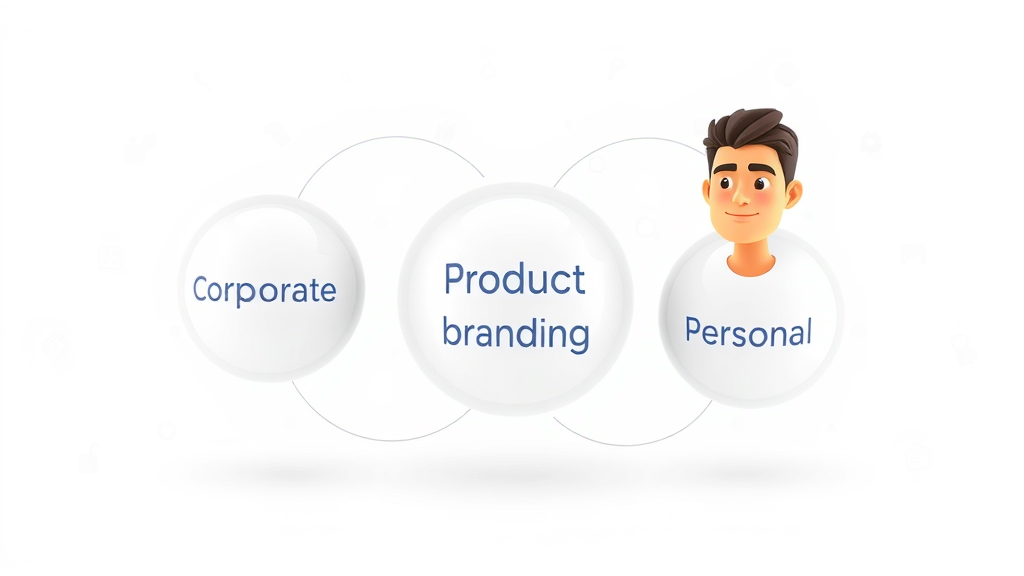Did you know that nearly 90% of consumers believe a company’s corporate branding dictates their purchasing decisions—yet a single branding misstep can cost millions in lost revenue? Your brand isn’t just a logo or slogan; it’s the heartbeat of your organization, influencing public perception, trust, and ultimately, your bottom line. Whether you’re an executive, a marketing professional, or an entrepreneur, understanding the pitfalls and best practices of corporate branding is non-negotiable if you aim to thrive in today’s market. Dive in and discover how to fortify your corporate branding strategy, avoid million-dollar mistakes, and outshine your competition.
Why Corporate Branding Matters: Revealing the Real Cost of Branding Mistakes
Corporate branding touches every facet of your business, from customer loyalty to market share. A strong corporate brand can turn customers into lifelong advocates, but even small branding mistakes—like inconsistent messaging or failing to adapt to new market trends—can erode trusted reputations and result in substantial financial repercussions. For example, global companies have lost millions after failed rebrands or tone-deaf advertising campaigns, highlighting just how fragile brand equity is. The story isn’t limited to mega-brands; even mid-sized firms can see sales plummet when branding efforts go astray, leading to widespread loss in consumer confidence and stakeholder trust.
In this guide, you’ll unlock essential insights about top corporate branding mistakes, building an effective brand strategy, the difference between corporate and personal brands, and real-world corporate branding examples to learn from. By understanding the true stakes and opportunities tied to your corporate brand, you’ll be better equipped to safeguard your organization from costly missteps and drive powerful marketing outcomes.
- Discover the top corporate branding mistakes that cost companies millions
- Learn how to build a robust and agile brand strategy
- Compare corporate branding, personal branding, and product branding
- Analyze actionable branding examples—successes and cautionary tales alike

Defining Corporate Branding: What Is Corporate Branding and Why Is It Essential?
Corporate branding is more than just a corporate logo or a color palette—it's a comprehensive strategy that shapes how the world perceives an entire company, not just a single product or service. An effective corporate branding strategy aligns your brand image, mission, messaging, and even your visual identity to tell a unified story. This story resonates across every customer touchpoint and cements your position in the market as a strong corporate brand .
Corporate branding is essential because it represents the soul of your organization. It fosters trust with stakeholders, clarifies your brand personality, and differentiates you from competitors. Where a product brand may entice with features, a corporate brand inspires with purpose and values, building the lasting connections that drive long-term success. Ignoring this crucial concept leads to brand dilution, confusion, and ultimately, costly missteps that can devastate a company's growth trajectory.
Understanding the Role of Corporate Branding in a Strong Corporate Brand
Sturdy corporate branding acts as the glue that unites all facets of a business under one recognizable identity. Instead of disjointed product branding and fragmented marketing campaigns, a cohesive brand strategy expresses the company’s vision and mission to employees, partners, and customers alike. This alignment encourages employee engagement, loyalty, and ambassador-like behavior that powerfully reinforces your company's market presence. When a company has a strong corporate brand , its stakeholders intuitively know what it stands for, improving corporate performance and value in the eyes of investors and consumers.
Corporate branding also speaks directly to internal culture. Alignment between your stated values and the lived employee experience creates brand advocates who deliver consistent customer service and reinforce your branding efforts . Ignoring this internal aspect can lead to a lack of authenticity and credibility in all public-facing communications, weakening the overall corporate brand .
The Difference Between Product Brand, Corporate Brand, and Personal Brand
While these terms are often used interchangeably, understanding their distinctions is critical when shaping an effective brand strategy . A product brand is tightly focused on a specific product or product line, targeting a niche market segment and emphasizing unique features or benefits. A corporate brand , by contrast, represents the entire organization—its ethos, culture, and overarching value proposition. Meanwhile, a personal brand is the distinct impression made by an individual, often a business leader or influencer, whose persona can amplify or detract from corporate messaging.
Getting these distinctions right is especially vital for companies that operate across multiple sectors or with various product lines. Misalignment between product branding and the overarching corporate brand can confuse customers and diminish loyalty, while an individual’s personal brand that clashes with corporate messaging can spark PR crises or stakeholder mistrust.
| Aspect | Corporate Brand | Product Brand | Personal Brand |
|---|---|---|---|
| Strategy | Company-wide, long-term vision | Focused on a specific product/service | Individual-driven narrative |
| Target Audience | All stakeholders, investors, public | Segmented consumer types | Followers, professional network |
| Branding Efforts | Unified messaging, visual identity, culture | Distinct product benefits, advertising | Personal content, thought leadership |
| End Goals | Market leadership, trust, loyalty | Product sales, brand recall | Influence, credibility, reputation |

The Foundations of Effective Corporate Branding Strategies
Core Elements of a Strong Corporate Branding Strategy
A strong corporate branding strategy is built on key foundational elements that define how your business is perceived at every stakeholder intersection. It starts with a clear brand mission and vision—your brand’s North Star. These guiding statements anchor every decision, from marketing campaigns to hiring practices, ensuring consistency. Next, a compelling value proposition sets you apart, clarifying why your audience should choose you over competitors. A defined brand personality —whether innovative, trustworthy, or customer-centric—helps humanize your brand and build emotional connections that endure market shifts.
Ensuring that your visual identity —including colors, typography, and logo—reflects these core values is essential. Equally, a branding guide provides detailed standards to safeguard consistency in messaging, imagery, and tone across all touchpoints. The outcome is a unified presence that is easily recognizable and hard to imitate, serving as a protective moat against competitive threats.
Common Branding Efforts That Define Successful Corporate Brands
Successful corporate branding efforts go beyond superficial aesthetics by incorporating storytelling, consistent values, and a dedicated approach to stakeholder engagement. Key tactics include launching coordinated marketing campaigns that echo the brand’s central promise across channels—from social media to TV advertising. Internal branding initiatives help align employees with corporate values, reinforcing your company’s purpose from the inside out. Every interaction, whether it’s customer service calls, press releases, or executive interviews, should reflect the same unified message and distinctive voice.
Another fundamental element involves leveraging feedback—listening to customers and employees to continuously refine your branding strategy . The most enduring brands treat branding as a living, breathing asset that evolves rather than a static marketing campaign. This ongoing attention ensures sustained relevance and makes your corporate brand an integral part of your business success.
Crafting a Distinct Corporate Identity and Visual Identity
Establishing a memorable corporate identity starts with translating your company’s culture, vision, and purpose into visual elements and messaging that immediately stand out in a crowded marketplace. Your visual identity —everything from logo design to font choices and brand color palette—should evoke the right emotional response from your target audience, projecting authenticity and trust. Consistency is crucial: every digital and physical asset, from your website to your office signage, must reflect these visual and cultural values.
But a strong corporate identity isn’t achieved overnight. It requires deliberate branding efforts such as detailed brand guides, regular audits of brand usage, and proactive adaptation as market trends change. Companies that invest in this process often enjoy greater customer loyalty, higher brand recall, and significantly reduced risk of costly miscommunications across markets.
“Your brand is what other people say about you when you’re not in the room.” – Jeff Bezos
Critical Corporate Branding Mistakes to Avoid
Neglecting Brand Awareness and Its Impact on Stakeholders
Overlooking brand awareness is among the most frequent—and costly—corporate branding mistakes. When your brand fails to maintain visibility or relevance in the market, it loses mindshare with customers, prospects, and investors. For example, poorly executed rebrands or inconsistent corporate messaging dilute your brand image, causing confusion and eroding established credibility. Stakeholders—including customers, employees, and partners—rely on solid brand recognition to feel confident in their association with your company. Without focused branding efforts , a brand can quickly become irrelevant, opening the door to competitors who are eager to claim your share of the market.
Consistent investments in brand awareness through targeted marketing campaigns , sponsorships, and community engagement are critical. The absence of such efforts leads to loss of trust, decreased customer retention, and an uphill battle in winning back mindshare. Companies that maintain high brand awareness enjoy increased loyalty, easier launches of new products, and resilient revenue streams even during challenging periods.
Overlooking the Target Audience in Corporate Branding Strategy
All too often, corporate branding strategies focus inward, losing sight of the needs and preferences of the target audience . When branding is built on executive assumptions rather than market research and actual customer feedback, brands risk alienating the very people they seek to serve. Failing to tailor messaging, visual identity, and value proposition to the intended audience can cause even the most innovative products and services to fall flat.
To avoid this pitfall, brands must continually engage in market analysis, persona development, and active listening. Realigning your corporate branding with the target audience ensures deeper emotional connections, improved conversion rates, and stronger advocacy. Strategic adaptation—not stubborn consistency—separates the most successful brands from those that fade into obscurity.

Lack of Consistency Across Social Media, Visual Identity, and Messaging
Consistency is the bedrock of every strong corporate brand . Inconsistent messaging across channels, fluctuating tone on social media platforms, or frequent changes in the visual identity can quickly erode trust with customers. Whether online, in print, or in-person, every brand touchpoint should reinforce a clear and cohesive message.
Maintaining rigorous branding guides and providing continual brand education for employees, partners, and vendors is crucial. Such consistency boosts brand recall and builds confidence in your corporate identity, making your organization the go-to choice whenever customers consider buying products or services in your space.
Misaligning Product Branding with the Overarching Corporate Brand
Disjointed product branding sends mixed signals, diminishing your overall corporate brand authority. When products don’t appear to fit within the parent company’s identity or diverge significantly in tone, audience, or promise, customers may question the reliability and integrity of the broader brand. This lack of alignment can result in lost sales, negative press, and, ultimately, decreased brand equity.
Ensuring a harmonious relationship between product brands and the main corporate brand strengthens overall brand perception, accelerates cross-selling opportunities, and reduces the risk of a single product misstep damaging the whole brand reputation.
Ignoring the Power of Branding Guides for Branding Efforts
A comprehensive branding guide is a vital tool for preserving your corporate identity and ensuring your branding strategy stays on track. Without one, brands are at the mercy of ad-hoc decision-making and fragmented execution—leading to inconsistency, confusion, and expensive corrective actions.
Branding guides should clearly define acceptable colors, fonts, tone of voice, imagery, usage rights, and more. Distributing and training all relevant staff with this guide ensures every element, from social media posts to print advertisements, aligns with the corporate vision and values.
- Tropicana’s Rebrand (2009): A packaging redesign confused loyal customers and cost the company over $30 million in lost sales within weeks.
- Gap Logo Change (2010): Abandoning a recognizable logo led to massive backlash and a quick, costly reversal estimated at $100 million.
- New Coke (1985): Changing the product and messaging alienated customers, costing Coca-Cola tens of millions and years to recover market share.
- BP’s Green Rebrand (2000): Inconsistent messaging and environmental missteps contributed to a significant loss of public trust and billions wiped from brand value following the Deepwater Horizon spill.
- RadioShack’s Rebranding (2008-2015): An unfocused strategy and lack of clear positioning resulted in bankruptcy and a brand wipeout.

Corporate Branding Examples: Learning from Branding Successes and Failures
Branding Examples: What Strong Corporate Brands Get Right
Brands like Apple, Nike, and Starbucks have consistently excelled by prioritizing brand awareness , showcasing clear values, and delivering a unified visual identity across every touchpoint. Their corporate branding efforts center on storytelling that forges emotional connections—think Apple’s focus on innovation or Starbucks’ commitment to community. Every interaction, from product launches to customer service, echoes these core values and solidifies their market leadership. These companies use robust branding guides to ensure every department and region maintains brand integrity no matter how global their reach grows.
The lesson is clear: a strong corporate brand isn’t built on marketing campaigns alone, but on steadfast consistency, purpose-driven leadership, and adaptable yet unwavering values. These brands also monitor market trends, listen to feedback, and adapt their brand strategies to seize new opportunities while preserving their essence.
Corporate Branding Examples: Major Mistakes to Learn From
On the other hand, brands like Yahoo!, Kodak, and Blackberry faltered not just from product missteps, but from lack of alignment between their product branding and the corporate brand . Yahoo!’s shifting identity and unclear market position, Kodak’s failure to embrace digital, and Blackberry’s late response to smartphone trends show that ignoring evolving market and audience expectations can erase decades of brand equity in a matter of years.
Each misstep in these corporate branding examples stemmed from losing touch with the target audience , neglecting internal culture, or failing to adapt to major market shifts—mistakes that offer clear lessons for any business seeking sustainable growth.
Case Study: How a Strong Corporate Brand Overcame Brand Strategy Failures
LEGO stands out as a shining example of how a focused corporate branding strategy can propel recovery. In the early 2000s, LEGO lost its way—overdiversification and inconsistent branding efforts pushed the company toward bankruptcy. A renewed focus on core values, streamlined product lines, and transparent communication rebuilt stakeholder trust. LEGO’s investment in a cohesive corporate brand combined with inclusive storytelling and community engagement, not only revived its fortunes but also made it one of the most beloved toy brands globally.
This case affirms the enduring value of understanding your brand identity , aligning your entire organization behind it, and being willing to evolve smartly without betraying your brand’s core promise.

Mastering Corporate Branding: From Strategy to Implementation
Building Corporate Branding Awareness Using Social Media
Social media is now a non-negotiable pillar of corporate branding . With billions of global users, social platforms empower brands to reach, engage, and emotionally connect with their target audience directly and in real time. Brands that master social media leverage content, storytelling, and interactive campaigns to strengthen brand awareness and foster loyalty. The immediacy of customer feedback on these platforms enables swift issue resolution and crowd-sourced innovation, giving brands a vital edge.
Brands like Wendy’s and Netflix have garnered massive attention for their consistent, witty, and often bold branding efforts on social media. Their success is rooted in authenticity, strategic brand voice, and sharp monitoring of platform-specific trends to keep messaging relevant and engaging.

Maintaining a Strong Corporate Brand in a Fast-Changing Market
Modern markets are turbulent, with technology and consumer expectations evolving at breakneck speed. Brands that endure proactively monitor trends, continually refine their branding strategy , and prioritize innovation while staying true to their brand DNA. This might mean regular audits to gauge public perception, gathering ongoing stakeholder feedback, and adjusting visual or messaging elements to stay aligned with core values and audience preferences.
These ongoing branding efforts prove that consistency does not mean stagnation. The most resilient brands are agile—adapting to change while ensuring every shift still feels unmistakably “on-brand.” Such focused adaptability is the hallmark of a strong corporate brand .
Ensuring Cohesion Across Corporate Branding Efforts
Brand cohesion is achieved when all parts of the organization—products, marketing, HR, leadership—echo the same message, tone, and values. This starts with a comprehensive branding guide and requires buy-in from leadership all the way to new hires. Regular internal training, open communication, and cross-departmental collaboration help reinforce this cohesion. Additionally, brands benefit from external audits and competitive benchmarking to ensure ongoing alignment in voice, imagery, and positioning.
The reward for cohesive corporate branding efforts is clarity in the marketplace, higher employee morale, and stronger consumer loyalty—crucial to weather crises or capitalize on emerging trends.
Evolving Your Corporate Identity for Sustainable Growth
Your corporate identity should never be static. As markets, technologies, and societal expectations evolve, so must your brand. Regular reviews of the company’s mission, visual identity , and messaging ensure ongoing relevance. Solicit feedback from all levels of the organization and from customers to recognize when subtle (or significant) adjustments are needed. Brands that evolve thoughtfully—staying consistent with their core, but open to change—are best positioned for sustained growth and customer loyalty.
By harnessing marketplace insights, proactive branding efforts , and a commitment to authenticity, companies unlock new growth opportunities while safeguarding their hard-earned brand equity.
People Also Ask: Expert Answers on Corporate Branding
What is the meaning of corporate branding?
Corporate branding refers to the process of defining and promoting the overall identity, values, and reputation of an entire company, rather than focusing on a single product or service. It encompasses visual identity, messaging, company culture, and stakeholder experiences to shape public perceptions and build long-term trust. A strong corporate brand sets an organization apart from its competitors and supports future growth.
What are the 5 C's of branding?
The 5 C's of branding are: Clarity, Consistency, Constancy, Credibility, and Connection. These principles ensure that your brand communicates a clear purpose, is reliably represented, engages with its audience regularly, builds trust, and forms strong emotional ties that foster loyalty over time. Embracing the 5 C's creates a resilient and recognizable corporate brand identity.
What are the 4 C's of branding?
The 4 C's of branding are: Clarity, Consistency, Competitiveness, and Connection. These guide a brand to develop a well-defined identity, present it uniformly across all touchpoints, distinguish itself in the marketplace, and build meaningful relationships with its audience. These core tenets are foundational for successful branding efforts in any industry.
What is the difference between branding and corporate branding?
Branding is a broad concept encompassing all activities aimed at creating a distinctive identity for products, services, or individuals. Corporate branding specifically focuses on shaping the overall identity and perception of an entire company or organization. While product or personal branding may highlight unique features or qualities, corporate branding unifies all business representations and drives the organizational culture.
Corporate Branding in the Digital Age: Trends, Challenges, and Opportunities
Digital Corporate Branding Strategies: Embracing Social Media Influence
The digital era has revolutionized corporate branding by making interactions instantaneous and far-reaching. Brands now leverage digital platforms to share stories, respond to audience feedback in real time, and cultivate communities. Embracing social media’s influence means staying transparent, agile, and engaging via interactive content, influencer collaborations, and viral campaigns that boost brand awareness globally.
Successful brands no longer rely solely on static advertising campaigns. They use data-driven personalized messaging, user-generated content, and real-time crisis management to stand out and maintain relevance in a noisy digital landscape.
Brand Awareness Campaigns: Using Data to Enhance Branding Efforts
Analytics and tracking tools empower brands to measure the performance of every marketing campaign , optimizing strategies and maximizing impact. Data-driven approaches allow companies to tailor campaigns, segment audiences, and allocate budgets to the most effective channels. Continuous monitoring of campaign metrics ensures that investments in branding efforts produce tangible lifts in brand awareness, engagement, and conversion rates.
By embracing big data, brands can identify trends sooner, react to consumer sentiment more effectively, and deploy targeted strategies that elevate their corporate identity .

Visual Identity and Messaging Trends for Strong Corporate Brands
Corporate branding trends today emphasize fluid, adaptive visual elements—such as dynamic logos, custom icons, and simplified color palettes—for maximum flexibility across digital and physical applications. Messaging has evolved to focus on empathy, sustainability, and inclusion, reflecting broader societal values. Brands that update their visual identity to stay modern while keeping messaging authentic create enduring, positive emotional resonance with consumers.
Staying ahead of trends requires ongoing analysis, regular creative refreshes, and a commitment to authenticity that ensures all updates align with your core brand promise.
Personal Brand vs. Corporate Brand: Is There an Overlap?
There is growing intersection between personal brand and corporate brand , especially in markets where charismatic leaders or influential employees represent the public face of an enterprise. Well-aligned personal brands can amplify corporate values, create additional trust, and attract new followers. However, misalignment or controversy at the individual level can directly impact the company’s broader reputation, making thoughtful brand governance and internal communication vital.
Smart organizations support leaders and employees in building genuine personal brands that echo, but do not overshadow, the core corporate brand—creating a harmonious, multidimensional presence in the public eye.
Expert Corporate Branding Tips and Best Practices
Avoiding the Most Common Corporate Branding Pitfalls
The biggest traps in corporate branding include prioritizing style over substance, ignoring shifting market dynamics, neglecting internal culture, and failing to update strategies for the digital era. Preventing these pitfalls requires regular brand audits, continual learning, and fostering a culture where feedback is welcomed and acted upon. Clear branding guides , ongoing staff training, and proactive adaptation to new trends are critical to long-term brand vitality.
Treat branding as a continuous process—never a “one and done” project. An agile, informed approach shields your brand from costly errors and ensures it remains a market leader.
Actionable Steps to Boost Corporate Branding Efforts
To enhance your corporate branding efforts , start with a detailed review of your core values, mission statement, and visual identity . Seek regular feedback from stakeholders and review competitor brand strategies. Invest in employee training—your staff are your first brand ambassadors. Track brand awareness metrics and be ready to pivot based on changing market feedback. Finally, connect every initiative, from product launches to social media posts, back to a unified messaging and design system.
Organizations that embed branding best practices into every process enjoy greater resilience, stronger relationships with stakeholders, and higher return on investment from all marketing activities.
- Create and share a comprehensive branding guide with all employees
- Conduct quarterly brand awareness and consistency audits
- Regularly update visual assets to reflect current trends while maintaining core identity
- Consistently engage with your audience on social media and in person
- Foster open feedback channels across all organizational levels

| Branding Action | Purpose | Expected Outcome |
|---|---|---|
| Develop Branding Guide | Set clear standards for all branding elements | Consistent and unified brand presentation |
| Brand Training Programs | Educate staff on brand values and messaging | Employees as brand ambassadors |
| Social Media Engagement | Direct interaction with target audience | Enhanced loyalty and real-time feedback |
| Quarterly Brand Audits | Identify inconsistencies and market shifts | Fast adaptation, stronger resilience |
| Regular Visual Updates | Stay relevant with visual identity trends | Modern, appealing brand image |
Frequently Asked Questions about Corporate Branding
How can a company measure the success of its corporate branding strategy?
Companies can measure branding success using a combination of quantitative and qualitative metrics. Track brand awareness through surveys, analyze social media sentiment, measure engagement and conversion rates, and monitor brand equity scores from market research. Combining hard data with stakeholder feedback paints a comprehensive picture of branding effectiveness.
What role does a branding guide play in corporate branding?
A branding guide codifies every aspect of your brand, from logo usage and color schemes to messaging tone and content style. This document ensures everyone in the company represents the brand consistently, regardless of department or location—preventing costly errors and enhancing overall brand integrity.
Why is consistency crucial in corporate branding efforts?
Consistency builds credibility, trust, and recall. When customers encounter the same visual identity, voice, and messaging across all touchpoints, they form a reliable perception of your brand. Inconsistent branding confuses customers, dilutes your market position, and undermines brand loyalty, making consistency an absolute necessity for strong corporate branding.
Final Thoughts: Building and Protecting a Strong Corporate Brand
Key Takeaways for a Resilient and Memorable Corporate Identity

“A strong corporate brand is built over time, but it can be damaged in an instant.”
Next Steps: Elevate Your Corporate Branding Strategy Today
Ready to guard your brand against costly mistakes? Take immediate action—conduct a brand audit, update your branding guide, and empower your team to be brand ambassadors. Cohesive, agile branding is within your reach.
Ready to Redefine Your Corporate Branding? Let’s Map Your Brand’s Future
Let's have a chat, call 904-385-5213
To deepen your understanding of corporate branding and its critical role in business success, consider exploring the following resources:
- “Corporate Branding: Successful Strategies for Branding Your Company” ( themarketinghustle.com )
This article delves into key elements of corporate branding, such as logo design, company mission, and brand voice, providing actionable steps to develop a cohesive brand identity.
- “Corporate Branding Strategies for Business Growth” ( arounda.agency )
This resource outlines strategies to enhance corporate branding, including improving employee engagement and analyzing competitors’ branding approaches, to drive business growth.
By studying these materials, you’ll gain valuable insights into building and maintaining a strong corporate brand that resonates with your audience and stands out in the marketplace.
 Add Row
Add Row  Add
Add 



Write A Comment